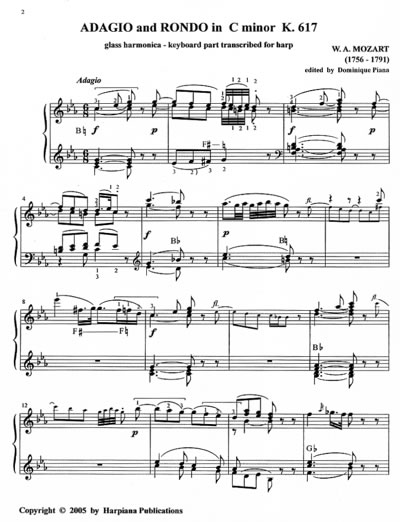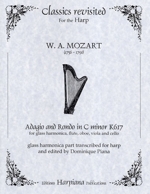| Editions
Harpiana Publications: Classics Revisited
Glass Harmonica part transcribed for harp by Dominique Piana Buy this music now Score: £12.00 + p&p
|
| Editions Harpiana Publications - Index of works |
In the last year of his life, before immersing himself body and soul into the Magic Flute, Mozart wrote the Adagio and Rondo for glass harmonica, flute, oboe, viola, and cello as a vehicle for the renowned blind performer Marianne Kirchgessner. Musical glasses, originally from Persia, had gained popularity in mid-18'h century Europe. They were originally graded by size, tuned through the addition of water to raise the natural pitch, and played by moistened fingers on the sides and rims. Benjamin Franklin heard such an instrument on a visit to England in 1761 and, enchanted, decided to improve it: he positioned a series of graded glass basins on a horizontal spindle, made to revolve by a crank attached to a foot pedal, and called it the armonica. With further improvements by J.S. Schmittbauer, including an expanded range of four octaves, the glass harmonica gained great popularity in Germany and Austria. However, the very sweetness of the instrument, with the vibrant and ethereal tone that made it so attractive in the first place, may also have caused its demise. On account of its hypnotic effect on the listeners, hypnotists began to use it in their sessions. Furthermore, with overuse, some people perceived the permanence of extremely high partials as irritating to the nerves. You will notice that the glass harmonica part is entirely written in the treble clef range. The touring harpist Nicanor Zabaleta launched the custom of performing the glass harmonica part of the Adagio and Rondo on the harp in the 1960's. A rarely heard piece because of its unusual blend of instruments, it nonetheless features Mozart at his finest: simple yet elaborate, and with highly expressive chromaticism, well thought out remote modulations and a richly fleshed out texture. The combination of instruments proves particularly felicitous, as the viola and the cello supply the lower range needed to balance out the winds and the harp. The harp part has been edited as faithfully as possible to the original score, with the intention of providing a workable lay out facilitating reading and page turns, strategic entrance cues as well as some "true and tried" fingering and pedaling. A single note has been altered to make the pedaling work: at m. 15 the low f was substituted for the original a natural. One challenge was hard to overcome in performance: like the glass harmonica, the harp keeps on ringing...its the additional hum resulting from the pedal changes that is unwelcome in such transparent textures, yet hard to avoid. Mr. Zabaleta had an 8th pedal installed on his harp for the purpose of muffling the wire strings. In the context of this highly desirable addition to the repertoire, such technology would be highly desirable; in its absence, some judicious muffling techniques will need to be applied. Only the solo harp part is supplied in this edition, the score and the other instrumental parts are available from International Music Company in New York. Françoise Bourret typeset the music in Finale. Dominique Piana

| Title: | Adagio
and Rondo in C minor K617 for glass harmonica, flute, oboe, viola and cello |
| Composer: | Mozart |
| Arranger: | Glass harmonica part transcribed for harp and edited by Dominique Piana |
| Instrumentation: | Harp, flute, oboe, viola and cello |
| Level: | Intermediate to Advanced |
| Format: | Harp Part stapled |
| Size: | 11" x 8.5" (US Letter) |
| ISMN: | Not issued |
| Our Ref: | DP002 |
| Publisher: | Editions Harpiana Publications |
| Series: | Classics Revisited |
| Edition/Year: | 2005 |
| Origin: | USA |
